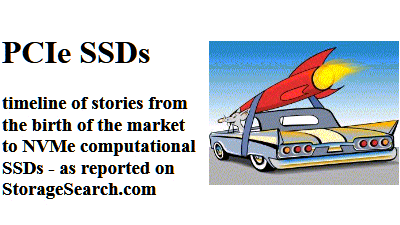|
IBM is the world's largest
information technology services and consulting provider. Some 190,000
professionals in more than 160 countries help clients integrate information
technology with business value -- from the business transformation and industry
expertise of IBM Business Consulting Services to hosting, infrastructure,
technology design and training services. IBM services business delivers
integrated, flexible and resilient processes across companies and through
business partners, enabling clients to save money and transform their businesses
to be more competitive. For more information, visit www.ibm.com/services.
See also:-
IBM
- mentions on StorageSearch.com,
IBM's flash storage
page
popular
SSD articles
A
Storage Architecture Guide
the SSD Bookmarks -
suggestions from IBM
Auto-tuning SSD
Accelerated Pools of storage
enterprise adoption
of naughty new flash - 2004 to 2018
|
| . |
This is the first time that
an SSD company which focuses on "in-situ processing" has reached the
exalted top 5 region of this list.
This is as significant in its own way as when in earlier periods we
saw PCIe SSD companies do well in this list (such as when Fusion-io entered the
top 10 in 2008) and similarly when we saw NVDIMM SSD companies get high entries
in the list (Diablo in 2014). |
| Top SSD Companies in Q3
2016 | | |
| . |
|
| . |
Who's who in SSD? - IBM
by Zsolt Kerekes,
editor StorageSearch.com -
April 28, 2014
IBM was ranked #2 in the
Q1 2014 edition of
the Top SSD Companies
published here on
StorageSearch.com - having moved up
9 places from the previous quarter. (This IBM's highest rank to date - in the
7 years of publishing this series.)
That was a strong affirmation that
the SSD market is interested in what it sees IBM doing in the enterprise.
That
interest was weighted more towards IBM's rackmount storage systems than in
its server side SSD solutions at the time of measuring this - although of
course - that could change.
See also:- -
It's IBM Jim -
but not as we know it |
|
Editor's comments:- re IBM and SSDs
- September 2012
It took many years for
IBM's
SSD strategy to materialize into a recognizable shape.
Like other
server companies - initially it was not in IBM's interests to
educate customers
about SSDs because they feared it would reduce server sales. But as I predicted
in my 2003 SSD market
adoption article - as soon as user knowledge about SSDs reached a critical
mass and other server makers started to adopt them - server makers like IBM
potentially realized they would lose server sales if they didn't support them.
Before their born-again enthusiasm for SSDs - IBM (in 2006) had
publicly ridiculed products from SSD makers such as Texas Memory Systems - and /
or claimed that other SSD products in the market weren't good enough to use
yet. (A similar ploy to another SSD latecomer
Seagate.)
Like
many other server companies IBM initially went for the "safe" option
of remarketing, reselling or
rebadging proven
SSD products from companies like
Fusion-io,
STEC,
SanDisk and others.
IBM's
recently announced agreement to acquire
Texas Memory Systems
(August 2012) has within it the potential to rapidly scale into a multi-billion
dollar revenue SSD business unit. |
| . |
|
|
July 2007 -
SanDisk announced that
its SATA 5000 2.5-inch SSD will be offered as an option in IBM's new
BladeCenter HS21 XM.
April 2008 -
IBM Previews Racetrack Solid State Storage
August 2008 -
Fusion-io's SSDs were the secret ingredient in an
IBM
"million IOPS" story.
September 2008
- IBM announced a technology collaboration with
Fusion-io
In
February 2009
- IBM published a well written article -
SSDs
for Enterprise Storage (pdf) which introduces the need for SSD acceleration
and explains IBM's strategy in this market.
In May 2009 -
STEC confirmed that its
SSDs are oemed in several popular
IBM servers and storage
systems.
In December 2009 -
Fusion-io
announced
that its ioMemory PCIe
SSD technology has been adapted by IBM who will remarket these
solutions (initially with upto 320GB capacity) as its
High
IOPS SSD PCIe Adapters for use in System x servers.
In August 2012 -
IBM
announced it will
acquire Texas
Memory Systems
In January
2014 - IBM
disclosed it had shipped over 1,500 fast
rackmount SSDs in
its FlashSystem 800 range - based on the RamSan product line acquired from
Texas Memory Systems.
IBM also launched a new range of servers which were the first in the market to
include - as standard -
memory channel
SSDs (low latency DDR3 DIMM flash SSDs) supplied by
SanDisk and based on
the design created by SMART
and Diablo.
In
May 2015
- IBM
announced
it had been the number #1 all-flash storage array vendor in
2014,
having shipped more petabytes and units for Solid-State Arrays than any other
competitor - citing an industry market report from
Gartner.
IBM said that in 2014 it had sold more than 2,100 FlashSystems, totaling 62
petabytes of
capacity.
"With over a third of the world's 2014 all-flash array
capacity on IBM FlashSystem, this solution is proving itself as the all-flash
enterprise storage solution of choice across Tier 1 enterprise and cloud
deployments around the world," said Michael Kuhn, VP and
Business Line Executive, IBM Enterprise Storage. |
| . |
 |
| . |
more SSD articles you may
be interested in - here on StorageSearch.com
SSD history
DIMM wars
what's the state of DWPD?
controllers for big
SSD architecture
where are we now
with SSD software?
an
introduction to enterprise SSD silos
how fast can your SSD
run backwards?
the Survivor's
Guide to Enterprise SSDs
Auto-tuning SSD Accelerated
Pools of storage
a guide to
semiconductor memory boom-bust cycles
High availability
fault tolerant SSD arrays market
usable flash
SSD capacity - the iceberg syndrome
What were the big
SSD ideas to learn and forget in 2015?
latency reasons
for fading out DRAM in the virtual memory mix
|
| . |
|
| . |
|

| |
| re IBM's
FlashSystem 9100 |
Editor:- July 18, 2018 - A recent blog -
Introducing
the FlashSystem 9100 NVMe with FCM - by Barry Whyte at IBM - provided for me - a
satisfying sequel and finale to the story of whatever happened to the longest
running enterprise SSD accelerator product line in the history of the market -
the SAM>RamSan>FlashSystem - which were all
fast big shared memory boxes.
(The new heir in the family saga -
the FlashSystem 9100 is a 2U box with NVMe SSDs inside which provides 403TB
usable uncompressed - and GbE, FC or SAS host connectivity.)
You can
get a taster of the family story in these 2 marker articles - selected from
my numerous scribblings.
IBM's FlashSystem 9100?
It's
the same kind of horse show (in
market
role) but with a different technology animal inside and the recent
changes in the design architecture today in 2018 are as significant as when TMS
redesigned the main memory array in the RamSan product line from RAM to flash in
their 2007 model - the
RamSan-500.
Barry Whyte's new blog says among things:-
"The
storage development team in Hursley started work on the design of a new
generation box back over 3 years ago when I was still based in the UK. The idea
was to build a low rack density, and high performance control enclosure that
could take NVMe Flash drives, both in terms of NAND Flash based, and look to the
future of SCM technologies, such as 3D Xpoint, Z-SSD and whatever else will
come along." ...read
the blog
Editor's comments:- throughout the 30 or so years
history of the RamSan and the multi OS supported SAM - Shared Access Memory
system which came before and the new FlashSystem (which cane after (and which
may have changed its name again depending on when you read this) is the the
idea of a product line which evolves to accomodate new memory technologies but
retains the legacy purpose of putting data in a box where it can be accessed by
many different servers at the lowest practical latency cost.
See also:-
rackmount SSDs | | |
| .. |
 |
| .... |
| NVMe and
the FlashSystem 900? |
Editor:- December 7, 2016 - NVMe was one of the
big
SSD ideas of the year which was mentioned by several contributors.
Hold
onto that thought.
"The only thing better than an improved
protocol like NVMe, is no protocol" - says Woody Hutsell,
Technologist, Evangelist - IBM in his new blog -
Stop
waiting on NVMe all flash arrays.
Among other things Woody says -
"There is no storage protocol inside the IBM FlashSystem 900. Once the
data hits the interface controller it ceases to be SCSI or PCI or NVMe. The
only thing better than an improved protocol like NVMe, is no protocol. The
FlashSystem 900, like many prior generations of FlashSystem solutions treats the
flash inside the system like memory. The result is unmatched latency
characteristics." ...read
the article
Latency was the central theme of Woody's
SSD bookmarks for
StorageSearch.com readers earlier this year too.
Woody has been
extolling the virtues of low latency enterprise SSD storage to me and my
readers for over 15 years.
I always relax when reading Woody's
writings about solid state storage as I can be secure in the knowledge that
everything he says is reliable. | | |
| .. |
|
|
| .... |
 |
| .... |
|
|
| .. |
| What got me thinking about
the need to write this blog was thinking back to a bunch of conversations I had
on the subject of those many small flash array vendors whose marketing
communications energies seem to be inappropriately overinvested in theme songs
and musicals which compare their star products with those of EMC. |
| "compared
to EMC" | | |
| .. |
| Don't worry about the
endurance of our FlashSystems |
Editor:- October 7, 2014 - Worried about
endurance?
"None of the thousands of
FlashSystem
products (fast rackmount SSDs) which IBM has shipped has ever
worn out yet! - says Erik
Eyberg, Flash Strategy & Business Development at IBM - in his new
blog -
Flash
storage reliability: Aligning technology and marketing. "And our
metrics suggest that will remain true in almost all cases for many, many years
(certainly well beyond any normal and expected data center life cycle)" | | |
| .. |
|
|
| .. |
| IBM aims to be
multi-billion dollar flash systems supplier |
Editor:- April 12, 2013 - 3
years ago I wrote a blog
about the confusing nature of the "RamSan" brand of SSDs from Texas Memory Systems
given that all the recent models in the family were in fact
flash memory rather than
RAM based - and
furthermore some of the models didn't connect via an
FC SAN but used
PCIe instead.
So
it wasn't a surprise to see in yesterday's
announcement
by IBM (who
acquired TMS
last year) that the RamSan designation has been dropped in favor of the more
accurate sounding "FlashSystem" in those models which migrated
intact to IBM's
enterprise flash product line.
So - for example in the category of
high
availability rackmount SSDs - the old RamSan-720 (SLC) and RamSan-820
(MLC) have become the new
IBM
FlashSystem 720 and 820.
If you're not already familiar with
these fast HA SSDs - the thinking behind their design came out in an
interview I has with
Holly Frost, CEO of TMS when they were launched in
December 2011.
Unless
I missed them - then it doesn't look to me as though TMS's PCIe SSD models
have been so fortunate. I couldn't see them in IBM's range of PCIe SSDs (High
IOPS Modular Adapters) which are based on products and technologies from
Fusion-io and
LSI.
That
no-show may be due to the fact that - unlike TMS's rackmount systems which
were software agnostic - a lot more work is required to efficiently integrate
server based SSDs into a wide range of server products. But I anticipate
that TMS's big
architecture SSD controller technology will resurface in future IBM SSD
cards.
Much more significant was the news that IBM is investing
$1 billion in research and development to design, create and integrate
new flash solutions into its portfolio of servers, storage systems and
middleware. IBM also announced plans to open 12 centers of flash competency
around the globe. That demonstrates confidence in the
future scale of the
SSD market and its
perspective related
to computer history. | | |
| .. |
|
| .. |
|
| .. |
|
| |





